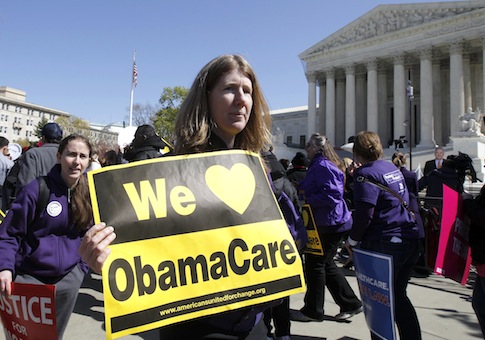A pair of recent regulations highlights the administration’s desire to undermine the private healthcare market and strengthen the government’s grip over healthcare in America.
Liberals have argued that Obamcacare employs conservative means—including marketplaces and individual choice—to reform the healthcare industry, citing certain aspects of the law developed by a conservative think tank and a Republican governor.
However, changes to Medicare Advantage and Medicare Part D reveal a deep-seated opposition to the individual choice and market-based reforms that conservatives have championed.
Both programs were created in 2003 as part of the Medicare Modernization Act championed by George W. Bush. Both use a "premium support" model, in which the government gives each person a set amount of money to use toward the cost of the insurance, and then allows the individual to choose which plan to buy.
The first regulation, released late on Friday, reduces the amount the government pays toward each private Medicare Advantage plan.
Medicare Advantage grew by nine percent last year; over a quarter of Medicare enrollees now participate in the program. The program was a stark departure from the government-centric vision of healthcare that traditional Medicare represented, as enrollees pick which private insurance plan they want.
Medicare Advantage has always cost the government more than traditional Medicare because its designers wanted to make it competitive with traditional Medicare and because many who use traditional Medicare also have a supplemental insurance plan provided by their employer that covers any costs not paid for by traditional Medicare.
The new regulation attacks the cost disparity by bringing the costs of Medicare Advantage in line with traditional Medicare. Because of the funding cuts, private plans offered through Medicare Advantage will become less enticing and fewer people will move into the private market.
As a result, the federal government will retain its control over healthcare for the elderly. Medicare Advantage threatened that control, and reducing payments to it will undermine its popularity.
The second regulation, released in January, represents a similar threat to the health of the private insurance market for prescription drugs.
Medicare Part D works similarly to Medicare Advantage, in that the government gives seniors a set amount to put toward the insurance plan of their choice. Conservatives have often pointed to Medicare Part D as an example of how a premium-support model of health insurance could keep costs down by promoting competition.
The regulation affects the Part D market in several ways: It allows the government to interfere in negotiations between insurance companies and pharmacies, it limits the number of plans that insurance companies can put forward in the market, and it effectively does away with preferred networks of pharmacies.
Some conservatives, such as Douglas Holtz-Eakin of the American Action Forum, say the changes could drive up costs by hurting competition and the health of the market.
The elimination of preferred networks threatens the ability of insurers to keep costs down. In a preferred network, pharmacies sell drugs at a lower price in exchange for being "preferred" pharmacies under an insurance plan. The greater volume of customers coming to the pharmacy allows the pharmacy to offer lower prices.
Insurance companies will no longer be able to contract with a select few pharmacies to offer preferred rates under the new regulation. Instead, all pharmacies can choose to offer preferred rates if they want. The likely result of this change is that preferred networks will become extinct and rates will rise.
These changes to both parts of Medicare are likely to be unpopular. A bipartisan group of senators sent a letter to the administration last week asking it to reconsider the payment cuts to Medicare Advantage: "We urge you to maintain payment levels that will allow [Medicare Advantage] beneficiaries to be protected from disruptive changes in 2015," the senators wrote.
When the administration threatened to make similar cuts last year to Medicare Advantage, pressure from the industry and politicians caused the administration to relent and instead raise payments to the plans.
Millions of people are also in the Medicare Part D preferred networks, according to an analysis from the American Action Forum, and 90 percent of people say they are happy with their Medicare Part D insurance. If these people see their rates increase, insurance companies and politicians could make a similar push for the administration to relent.
It is not clear the administration will relent, however. Both of these regulations have the net effect of strengthening federal control over America’s health insurance industry, which is in line with the liberal vision for healthcare.
The left’s ideal healthcare arrangement is Europe’s single-payer model, where the government funds, and often controls, healthcare providers. Some Democrats have conceded that Obamacare is simply a step toward a single-payer system.
Medicare Advantage and Medicare Part D gave consumers more power, and as a result they were a step away from the single-payer system.
The Obama administration’s latest regulations are attempts to rein in these conservative innovations and return greater control to the government.
